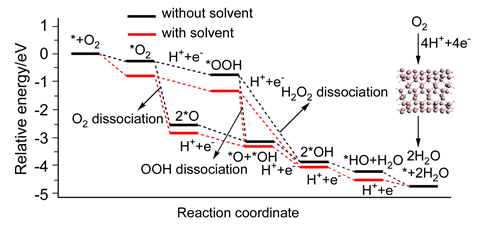| [1] Peng, S.; Xu, X.; Zhang, J.; Liu, Y.; Lu, S.; Xiang, Y. Acta Chim. Sinica 2015, 73, 137. (彭思侃, 徐鑫, 张劲, 刘祎阳, 卢善富, 相艳, 化学学报, 2015, 73, 137.)
[2] Xu, X.; Peng, S.; Zhang, J.; Lu, S.; Xiang, Y. Acta Chim. Sinica 2016, 74, 271. (徐鑫, 彭思侃, 张劲, 卢善富, 相艳, 化学学报, 2016, 74, 271.)
[3] Cheng, F.; Chen, J. Chem. Soc. Rev. 2012, 41, 2172.
[4] Cao, R.; Lee, J. S.; Liu, M.; Cho, J. Adv. Energy Mater. 2012, 2, 816.
[5] Bashyam, R.; Zelenay, P. Nature 2006, 443, 63.
[6] Wu, G.; More, K. L.; Johnston, C. M.; Zelenay, P. Science 2011, 332, 443.
[7] Lefevre, M.; Proietti, E.; Jaouen, F.; Dodelet, J. P. Science 2009, 324, 71.
[8] Kattel, S.; Wang, G. J. Phys. Chem. Lett. 2014, 5, 452.
[9] An, L.; Huang, W.; Zhang, N.; Chen, X.; Xia, D. J. Mater. Chem. A 2014, 2, 62.
[10] Cao, B.; Veith, G. M.; Diaz, R. E.; Liu, J.; Stach, E. A.; Adzic, R. R.; Khalifah, P. G. Angew. Chem., Int. Ed. 2013, 52, 10753.
[11] Chen, X.; Qiao, Q.; An, L.; Xia, D. J. Phys. Chem. C 2015, 119, 11493.
[12] Chen, X.; Chen, S.; Wang, J. Appl. Surf. Sci. 2016, 379, 291.
[13] Jiao, Y.; Zheng, Y.; Jaroniec, M.; Qiao, S. Z. J. Am. Chem. Soc. 2014, 136, 4394.
[14] Nayak, S.; Biedermann, P. U.; Stratmann, M.; Erbe, A. Phys. Chem. Chem. Phys. 2013, 15, 5771.
[15] Nayak, S.; Biedermann, P. U.; Stratmann, M.; Erbe, A. Electrochim. Acta 2013, 106, 472.
[16] Seifert, G.; Köhler, T.; Hajnal, Z.; Frauenheim, T. Solid State Commun. 2001, 119, 653.
[17] Alam, K. M.; Ray, A. K. Nanotechnology 2007, 18, 495706.
[18] Rathi, S. J.; Ray, A. K. Nanotechnology 2008, 19, 335706.
[19] Nørskov, J. K.; Rossmeisl, J.; Logadottir, A.; Lindqvist, L.; Kitchin, J. R.; Bligaard, T.; Jonsson, H. J. Phys. Chem. B 2004, 108, 17886.
[20] Greeley, J.; Stephens, I. E. L.; Bondarenko, A. S.; Johansson, T. P.; Hansen, H. A.; Jaramillo, T. F.; Rossmeisl, J.; Chorkendorff, I.; Nørskov, J. K. Nat. Chem. 2009, 1, 552.
[21] Lee, K. R.; Jung, Y.; Woo, S. I. ACS Comb. Sci. 2012, 14, 10.
[22] Chen, R.; Li, H.; Chu, D.; Wang, G. J. Phys. Chem. C 2009, 113, 20689.
[23] Sha, Y.; Yu, T. H.; Liu, Y.; Merinov, B. V.; Goddard, W. A. J. Phys. Chem. Lett. 2010, 1, 856.
[24] Han, B. C.; Miranda, C. R.; Ceder, G. Phys. Rev. B 2008, 77, 075410.
[25] Anderson, A. B. Phys. Chem. Chem. Phys. 2012, 14, 1330.
[26] te Velde, G.; Bickelhaupt, F. M.; Baerends, E. J.; Fonseca Guerra, C.; van Gisbergen, S. J. A.; Snijders, J. G.; Ziegler, T. J. Comput. Chem. 2001, 22, 931.
[27] Lee, C.; Yang, W.; Parr, R. G. Phys. Rev. B 1988, 37, 785.
[28] Zhang, L.; Xia, Z. J. Phys. Chem. C 2011, 115, 11170.
[29] del Cueto, M.; Ocon, P.; Poyato, J. M. L. J. Phys. Chem. C 2015, 119, 2004.
[30] Ou, L.; Yang, F.; Liu, Y.; Chen, S. J. Phys. Chem. C 2009, 113, 20657.
[31] Roudgar, A.; Eikerling, M.; van Santen, R. Phys. Chem. Chem. Phys. 2010, 12, 614.
[32] Fang, Y. H.; Liu, Z. P. J. Phys. Chem. C 2009, 113, 9765.
[33] Hamada, I.; Morikawa, Y. J. Phys. Chem. C 2008, 112, 10889. |
